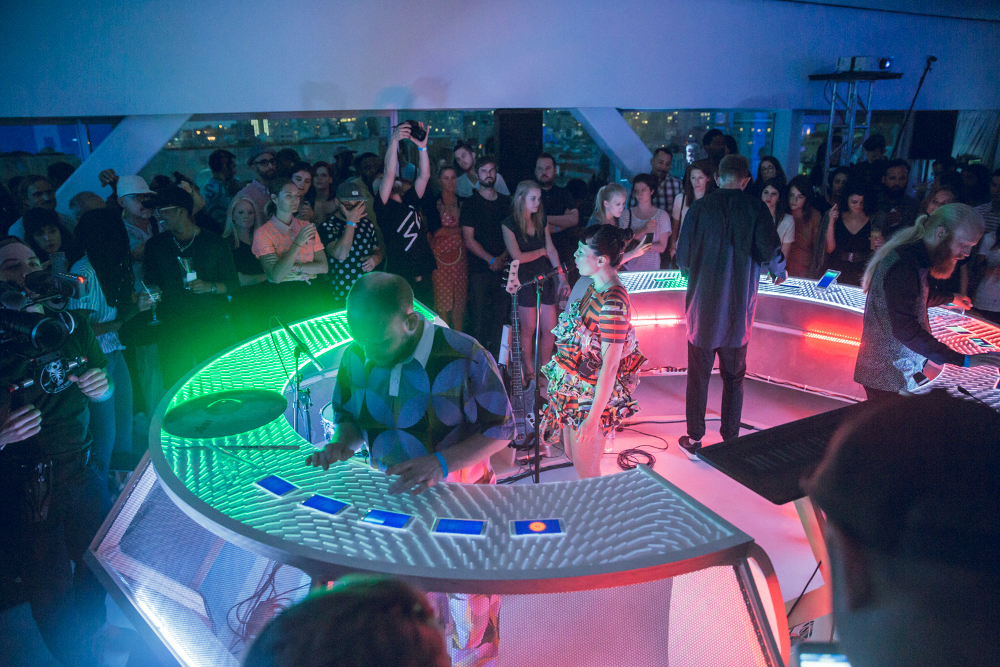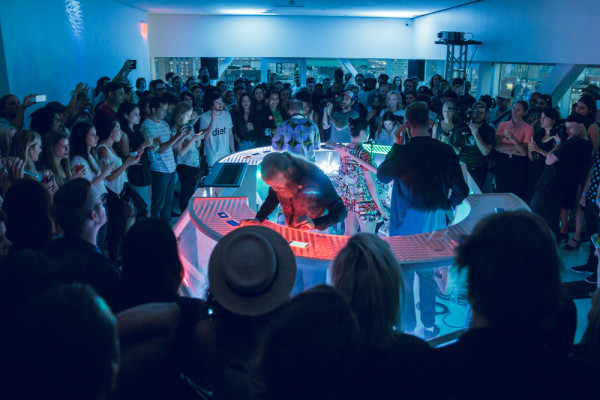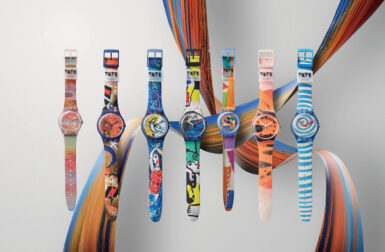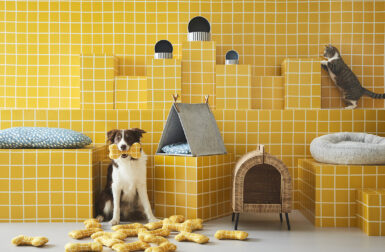Name a brand, and there is a good chance that Aramique Krauthamer of Odd Division has created some sort of transmedia experience for them – Nike, Cut/Copy, museums, non-profits, record labels, even Obama – if he hasn’t partnered with them yet, just give it some time. Rather than seeing his brand collaborations as a way to fund personal creative projects, Aramique doesn’t differentiate between the two. The Odd Division team has a plethora of ideas that they are just waiting for the right opportunity for in order to bring them to life. He said, “For us, brands are a vehicle to bring our ideas to life. As artists we need a way to fund our projects just like brands need a way to connect with audiences. So far it has worked out great for everyone.”
We caught up with Aramique just after Odd Division’s one-night only immersive experience on the rooftop of New York’s New Museum, with music by Swedish electronic band Little Dragon, curated by Protein to celebrate the release of Samsung’s Galaxy S6 edge. Little Dragon and Odd Division’s modular interactive instrument was an ode to space travel and steel drums and was created using eighteen Samsung Galaxy S6 edge phones, 4 custom software applications, 5 Ableton Live arrangements, and 1 LED placed inside a prototype flying saucer created just for the evening.
Aramique gave us the big picture look at what it takes to create an interactive experience for a major brand, as well as the gritty details on his digital file organizational system, his work style and thoughts on a work/life balance.
If you want to check out the phone instruments, they’ll be on display as part of the Red Bull Studios x NEW INC.’s Showcase for the month of July. You can play around with the instruments and check out the space ship installation, and Aramique will be on-site during show hours to explain the project.

The band’s initial conceptual sketch. The interface incorporated both the band’s musical needs and a visualization of their music, for the audience.
How did you get started creating interactive experiences?
I was really into the idea of transmedia experiences for a long time. This concept of an interactive narrative that exists across multiple platforms that the audience can get really immersed in. I started doing interactive music videos and web based experiences and evolved into physical experiences because I really enjoy seeing the audience reactions and meeting real people IRL. Jeff Crouse and I met at a Tribeca Film Festival hackathon where they invited directors and digital artists to partner together. We were partnered, having never met before, and have been collaborating since.
What do you find you are most inspired by?
I feel there’s an overwhelming amount of inspiration. From design movements of the past to emerging technology, there’s so much to absorb. I’ve started organizing things that inspire me, and the resulting ideas, into categories like architecture, light, engineering, film, graphic design, to remind myself to continue to pursue very different kinds of projects. Jeff Crouse, Mau Morgo and I all have different kinds of inspiration and we share with one another to take our ideas to new places.

The first synth prototype: As the band touched and swiped the phones, a real-time representation of the interface would be projected across the walls.
Can you describe your process in creating an experience like the one you did with Samsung?
The “Edge of the Universe” project with Samsung started with the idea of a musical instrument made with an array of phones that could be positioned and performed in any way. An app that could be installed on any number of phones so that a musician or group of musicians could perform anywhere without needing any gear. We had thought about a performance art piece using the long battery life of the phones where the performance lasted until the batteries died.
With Little Dragon, we talked about what the functionality of the instruments would be, what the structure would look like and what would make the performance unique. We always had the goal in mind of creating an app that could eventually be released to the public for others to use as well. We invited a few friends to join us to help focus on different pieces. Luisa Pereira joined to focus on the musical functionality, Lars Berg to work on programming visuals for the phones and projections and Ranjit Bhatnagar to help with the LED’s in the structure. The musical functionality was the most intensive back and forth with Little Dragon because we wanted them to take it to a new place and they needed to feel comfortable performing on a very different kind of instrument.
In thinking of the Samsung collaboration, what was the relationship between the phone/music/art that you wanted to highlight?
The idea began as a music app and evolved into an installation and a performance art piece. The phone is the natural vehicle because we were designing a mobile app to create an array of electronic instruments. This wasn’t a marketing project where we were trying to highlight anything in particular. We were simply using the phones as the controls for our spaceship and instruments and they were a natural fit.
You have a writing background — was there a traditional story-line/narrative in the project with Samsung or was it more of an abstract feeling that you were hoping to create?
I studied playwriting and poetry and have always used it in my work. I like to give enough story for people to begin imagining meaning but leave it open enough so that audiences can come to their own conclusions. The narrative for this project began when Little Dragon suggested a circular structure that could spin around them. I imagined a satellite flying off into space to capture sounds from a far off universe that Little Dragon could use to create musical instruments. They sampled audio from NASA and we designed the phones to feel like a control for a flyer saucer prototype. We decided from the beginning to place Little Dragon in the center of the room with no stage and no separation between the audience so that everyone would be going on this journey together.
When you’re working on a project like this, is there an aspect of it that comes easy to you?
The ideas come easy. The harder part is making them happen within short timeframes and budgets. Jeff Crouse and Luisa Pereira did a ton of work on the music and back-end side to make it come together so fast. Mau Morgo, Lars Berg and Ranjit Bhatnager worked around the clock to get the physical design, interface design, projections and LED programming ready and 11th St Workshop helped bring the fabrication together extremely fast as well. Having a great team is the most important thing.
Conversely, what was the most difficult/challenging part of this collaboration with Samsung?
We had never developed anything for Android before this project, so the app that would run on all the phones was the biggest unknown for us. We invited our friend from the New Museum Incubator Luisa Pereira to join us. She is an amazing musician and programmer and it was really great working with her and Little Dragon on all the musical functionality. Jeff Crouse said a number of times he was surprised how much easier it was developing for Android than iOS. We never expected that, so of course we added tons of other stuff. We decided to do a lot of different things on this project and there were times it seemed like we were insane but we wouldn’t have been happy with anything less.
How do you know if an event/experience has been a success?
The first thing is how we feel. You know in your gut if you’ve taken it as far as you can. Then the people arrive and you can see it in their faces. Wide eyes, smiles, curiosity. You want people to be present and engage with what you make, but the more people like something the more likely they are to start taking photos. We try to create things for people to participate in and share so it’s pretty easy to tell if something is a success. At the end of the night there was a couple making out against the wall covered in our projections. That was success to us.
Can you describe your style of working?
We work across multiple time zones between LA, NYC, Europe and Asia so our days can be very long depending where we are and who we are working with. Jeff Crouse is more of an early bird, Mau Morgo and I are more of night owls. I work at a desk, in cafes, in my car, on the couch, everywhere. Jeff and Mau are more structured working out of our studios in New York and Barcelona.
There seems to be a lot of technology at play in your work. What’s the relationship between the creative process and understanding that technology?
We are interested in using technology in ways that let audiences have new meaningful experiences. We are less focused on inventing something or solving problems and more passionate about exploring the possibilities of participation and immersive media. We get excited about new technology and imagine ways we would like to see it used.
Asking for all the design professionals out there: What is your organizational process for all your files, etc.?
Because we work in all different places it’s important for us to share files online. We use slack for collaboration and communication posting all of our files, brainstorming and managing productions.
You spend a lot of time on the road. What are some of your favorite places?
I like LA in winter and New York in summer. Really like New Orleans. Love Tokyo and Paris. I like being near the water or in the mountains or in any place with great light and good food.
Time balance is always a huge issue. How do you balance your time with your family vs. working etc.?
I spend at least 12 hours a day working and have very little balance in my life. When I start working on Saturday and Sunday my older daughter, who is only 4, reminds me that I don’t work on weekends and scolds me.
And what do your daughters think of your work?
My younger daughter is only 2 and has no idea yet what I do but she loves to say hi to Jeff Crouse and Mau Morgo on Skype. My 4-year-old daughter likes seeing all the stuff I make. She plays with 3D-printed figurines from music videos and loves all the crazy light stuff. Her favorite is a stop-motion music video I made using an articulated mannequin. Lately she’s been asking me to make weird things and asking what each person does on a project. She seems to be learning about ideas and always sharing hers with me. It’s important for me that they understand they can imagine things and then make them.
What other (living/working) artists inspire you?
Olafur Eliasson. Anish Kapoor. James Turrell.
What’s next for you?
We have a secret project we will be developing all summer in New York and also building our studio in Barcelona.
Thanks Aramique! Discover the new Samsung Galaxy S6 edge here.































